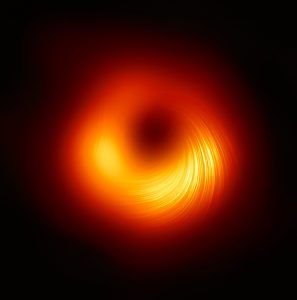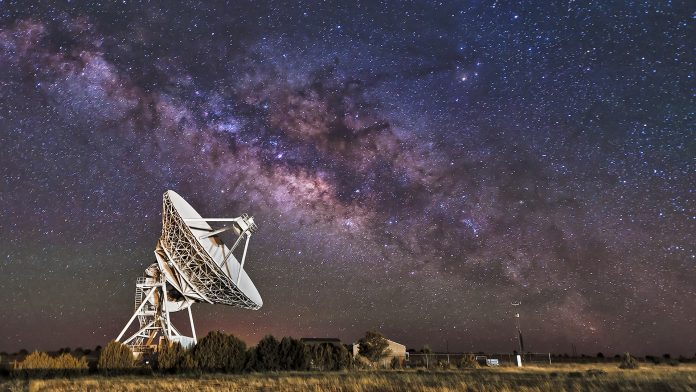The Event Horizon Telescope collaboration has measured polarisation, an indicator of magnetic fields, at the M87 galaxy black hole.
The Event Horizon Telescope (EHT) collaboration, which produced the world’s first image of a black hole, has now been able to measure polarisation, a signature of magnetic fields, close to the edge of a black hole.
These observations are significant in determining how the Messier 87 (M87) galaxy, which is 55 million light-years away, can launch energetic jets from its core.

https://www.eso.org/public/images/eso2105a/
Credit: EHT Collaboration
Monika Mościbrodzka, Co-ordinator of the EHT Polarimetry Working Group and Assistant Professor at Radboud University in the Netherlands, commented: “We are now seeing the next crucial piece of evidence to understand how magnetic fields behave around black holes, and how activity in this very compact region of space can drive powerful jets that extend far beyond the galaxy.”
In 2019, scientists released the first ever image of a black hole, showing a bright ring-like structure with a dark central region, which is the black hole’s shadow.
Since then, the EHT collaboration has more deeply explored the data on the supermassive object at the heart of the M87 galaxy collected in 2017. They have found that a considerable fraction of the light around the M87 black hole is polarised.
“This work is a major milestone: the polarisation of light carries information that allows us to better understand the physics behind the image we saw in April 2019, which was not possible before,” explains Iván Martí-Vidal, also Co-ordinator of the EHT Polarimetry Working Group and GenT Distinguished Researcher at the University of Valencia, Spain. He added: “Unveiling this new polarised-light image required years of work due to the complex techniques involved in obtaining and analysing the data.”
Light becomes polarised when it goes through certain filters, or when it is emitted in hot regions of space where magnetic fields are present; this polarisation enables astronomers to map the magnetic field lines present at the inner edge of the black hole.
EHT collaboration member Andrew Chael, a NASA Hubble Fellow at the Princeton Center for Theoretical Science and the Princeton Gravity Initiative in the US, commented: “The newly published polarised images are key to understanding how the magnetic field allows the black hole to ‘eat’ matter and launch powerful jets.”
The observations offer important new information about the composition of these magnetic fields, that lie just outside the black hole. The team discovered that only theoretical models featuring strongly magnetised gas can explain what they are seeing at the event horizon.
“The observations suggest that the magnetic fields at the black hole’s edge are strong enough to push back on the hot gas and help it resist gravity’s pull. Only the gas that slips through the field can spiral inwards to the event horizon,” said Jason Dexter, Assistant Professor at the University of Colorado Boulder, US, and Co-ordinator of the EHT Theory Working Group.
In order to observe the heart of the M87 galaxy, the collaboration included eight telescopes from around the world, including the northern Chile-based Atacama Large Millimeter/submillimeter Array (ALMA) and the Atacama Pathfinder EXperiment (APEX), to create a virtual Earth-sized telescope, the EHT.







